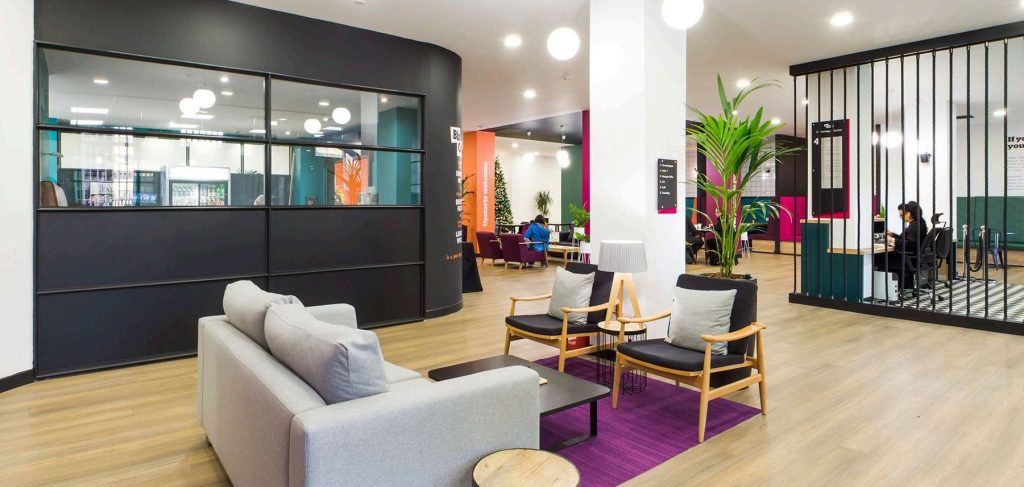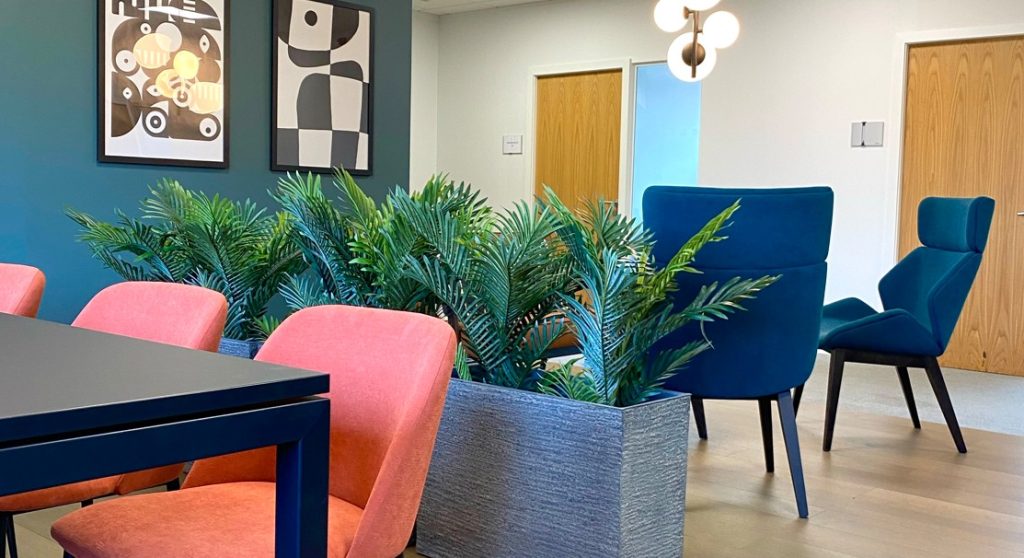Why Choosing a Full-Service Contractor Saves Time and Money

Whether you’re planning a commercial interior fit-out in Manchester or anywhere across the UK, the coordination of various contractors, suppliers, and specialists can quickly become overwhelming. This is where the value of a full-service contractor with comprehensive design solutions becomes apparent—a single point of contact that handles every aspect of your project from concept to completion. In today’s competitive business landscape, efficient commercial refurbishment and interior fit-out projects are crucial for companies looking to maximise their investment. At Rische Group, we’ve seen firsthand how our full-service approach to commercial fit-out delivers substantial time and cost benefits to our clients. Let’s explore why choosing a full-service contractor could be the most strategic decision for your next project. What Is a Full-Service Commercial Fit-Out Contractor? A full-service contractor offers end-to-end project management and execution services across all phases of construction or renovation. Rather than hiring separate entities for design, planning, construction, and interior finishing, you engage a single company with the expertise and resources to handle everything. This typically includes: Financial Benefits of Using a Full-Service Contractor 1. Consolidated Overhead Costs When you hire multiple contractors for your commercial refurbishment, each comes with their own administrative costs and profit margins. These costs compound quickly. By contrast, a full-service provider offers a unified fee structure that eliminates duplicate costs. Consider this: If you hire five separate specialists for different aspects of your commercial fit-out in Manchester, each with a 15% overhead cost, you’re effectively paying that premium five times. A full-service contractor charges this percentage only once—potentially saving thousands of pounds. 2. Integrated Design Solutions Save Money Having in-house design capability is a crucial advantage of leading full-service contractors. When design and construction teams work under one roof, they develop solutions that are both aesthetically pleasing and practical to build. Research shows that changes made during the construction phase can cost up to 20 times more than if addressed during design. A full-service contractor with strong design solutions expertise can identify potential issues early, preventing costly surprises later. 3. Bulk Purchasing Power Full-service commercial fit-out contractors maintain relationships with suppliers and can purchase materials in larger quantities. These economies of scale result in better pricing that’s passed on to you, often saving 10-15% compared to retail prices. 4. Reduced Likelihood of Expensive Errors When multiple contractors work in sequence without unified oversight, miscommunications occur. These can lead to expensive rework during your commercial refurbishment—perhaps walls need to be reopened to adjust systems that weren’t correctly coordinated. Industry data shows rework can account for 5-20% of a project’s contract value. A full-service contractor dramatically reduces these costly mistakes through consistent communication and centralised project management. Time-Saving Advantages of Full-Service Contracting 1. Streamlined Communication Channels Perhaps the most immediate time-saving benefit is having a single point of contact. Rather than managing communications with multiple entities for your commercial interior fit-out, you communicate with one project manager who coordinates everything. This streamlined approach eliminates the time spent: 2. Accelerated Project Timeline When a single company controls the entire commercial fit-out process, project phases can overlap rather than proceeding strictly sequentially. This parallel processing can reduce overall project duration by 15-30%, depending on complexity. Faster completion means earlier occupancy or rental income—a significant financial advantage particularly for commercial developments in competitive markets like Manchester. 3. In-House Design Capability Speeds Process A full-service contractor with in-house design capability eliminates the handover delays that occur when external designers must transfer their concepts to construction teams. When designers and builders work together daily, they develop a shared understanding that accelerates the entire process. For businesses planning a commercial interior fit-out in Manchester or elsewhere, this seamless transition from design to construction can save weeks on project timelines. 4. Faster Problem Resolution When issues inevitably arise during commercial refurbishment, full-service contractors can respond more quickly, drawing on their diverse in-house expertise to develop solutions without external consultations. For example, if a structural issue is discovered during construction, a full-service firm can immediately involve their design team to modify plans—potentially saving days or weeks of delay. The Critical Importance of In-House Design Capability One of the most valuable aspects of a full-service contractor is their in-house design capability. This integration of design solutions with construction expertise offers several unique advantages: In-house designers at full-service contractors understand construction costs intimately. They create commercial interior fit-out designs that achieve your aesthetic goals while remaining buildable within your budget—preventing the common scenario where beautiful designs must be scaled back once construction pricing is received. Designers who work alongside construction professionals daily gain practical knowledge about what works in the field. This results in commercial fit-out designs that not only look impressive but also perform well over time, avoiding common pitfalls that lead to maintenance issues. When unexpected conditions are discovered during a commercial refurbishment (perhaps asbestos or structural issues), in-house designers can quickly adapt plans without the delays and additional fees typically associated with external design consultants. With in-house design capability, your vision remains consistent throughout the project. There’s no risk of your design intent being misinterpreted when translated from a design firm to a construction team, ensuring the finished space matches your expectations. Real-World Results: Commercial Fit-Out Success Stories Retail Development: 5-Week Timeline Reduction For a high-street retail client requiring an urgent commercial fit-out, our parallel processing approach reduced the timeline by five weeks, allowing them to open before the crucial holiday shopping period—a competitive advantage that significantly impacted first-year revenues. Making the Right Choice for Your Commercial Fit-Out While full-service contracting offers compelling advantages, it’s important to select the right partner for your specific needs. Consider these factors when evaluating potential full-service contractors: Relevant Experience Look for contractors with proven experience in commercial refurbishment and fit-out projects similar to yours. Review their portfolio and request specific examples where their full-service approach delivered measurable benefits. Design Capabilities Assess the strength of their in-house design capability. Request examples of design solutions they’ve developed and implemented, and ask about their design process and how it
Sustainable Materials We’re Loving Right Now

In today’s commercial fit-out landscape, sustainability isn’t just a buzzword—it’s becoming a business imperative. As a leading provider of commercial interior fit-out in Manchester, Rische Group is committed to incorporating eco-friendly materials that reduce environmental impact without compromising on aesthetics or functionality. Our in-house design capability allows us to seamlessly integrate these sustainable options into our commercial refurbishment projects, creating spaces that are both beautiful and responsible. Here’s our showcase of the sustainable materials we’re particularly excited about right now, all of which we’ve successfully incorporated into recent design solutions. Reclaimed and Recycled Timber Why We Love It Timber brings warmth and texture to commercial spaces, but conventional sources can come with significant environmental costs. Our design solutions now regularly feature reclaimed and recycled timber options that tell a unique story while reducing demand for virgin resources. Recent Applications In a recent commercial interior fit-out in Manchester for a tech company, we transformed their reception area using reclaimed oak floorboards from a decommissioned warehouse. The character and patina of the wood created an immediate visual impact while aligning with the client’s sustainability objectives. For office partitioning in another commercial fit-out project, we utilised FSC-certified timber frames filled with recycled acoustic insulation, providing both sound dampening and environmental benefits. The natural grain variations added visual interest that synthetic alternatives simply couldn’t match. Environmental Benefits Cork Flooring and Wall Coverings Why We Love It Cork is experiencing a renaissance in commercial design, and for good reason. Harvested from the bark of cork oak trees without harming the tree itself, it’s a truly renewable resource that offers exceptional performance characteristics. Recent Applications For a recent commercial refurbishment of a financial services office, we installed cork flooring throughout circulation areas. The material’s natural resilience provided comfort underfoot while its acoustic properties helped dampen sound—a significant benefit in busy office environments. In another commercial fit-out project for a creative agency, we used cork wall coverings in meeting rooms to create a naturally sound-absorbent environment that didn’t require additional acoustic treatments. The visual warmth of the material created an inviting atmosphere for client presentations. Environmental Benefits Recycled Plastic Terrazzo Why We Love It Traditional terrazzo has been used for centuries, but modern versions incorporating recycled plastics offer an innovative twist on this classic material. Our design team is particularly excited about terrazzo made with recycled plastic from ocean waste and post-consumer sources. Recent Applications In a high-profile commercial interior fit-out in Manchester for a retail client, we created custom countertops using terrazzo made with recycled plastic bottles and fishing nets. The vibrant flecks of colour perfectly matched the brand’s identity while supporting their sustainability messaging. For a commercial refurbishment project in the hospitality sector, we specified recycled plastic terrazzo for bathroom surfaces, combining water resistance with environmental benefits in a high-traffic area. The material’s seamless installation minimized cleaning requirements while maximizing visual impact. Environmental Benefits Bamboo Architectural Elements Why We Love It While bamboo has been used in construction for centuries in some cultures, its application in modern commercial interiors is relatively recent. As one of the fastest-growing plants on Earth, bamboo represents an extremely renewable material choice for commercial fit-out projects. Recent Applications In a commercial interior fit-out in Manchester for a professional services firm, we used engineered bamboo for feature wall cladding that created a sophisticated natural backdrop for their reception area. The material’s natural variations provided visual interest while its hardness ensured durability in this high-traffic space. For another commercial refurbishment project, we specified bamboo for custom-built furniture pieces including meeting tables and storage units. The material’s strength-to-weight ratio made it ideal for these applications, while its rapid renewability aligned with the client’s environmental policy. Environmental Benefits Recycled Metal Fixtures Why We Love It Metal elements are essential in many commercial fit-out projects, but virgin aluminium and steel carry significant environmental impacts. Our design solutions increasingly incorporate recycled metals that offer identical performance with dramatically reduced carbon footprints. Recent Applications For a recent commercial refurbishment of a creative studio space, we specified light fixtures made from recycled aluminium that complemented the industrial aesthetic while reducing embodied carbon. The fixtures were designed for disassembly, ensuring they could be recycled again at end of life. In another commercial interior fit-out in Manchester, we used recycled copper accents for door hardware and decorative elements, providing an evolving patina that added character to the space. The material’s antimicrobial properties offered additional hygienic benefits in this client-facing environment. Environmental Benefits Implementing Sustainable Materials in Your Next Project Integrating these sustainable materials into your commercial fit-out or refurbishment project requires thoughtful planning and expertise. Here’s how our approach ensures success: Material Assessment Process Our in-house design capability includes a thorough material assessment process that evaluates: Balancing Aesthetics and Sustainability Many clients worry that choosing sustainable materials means compromising on appearance. Our design solutions demonstrate that eco-friendly options can actually enhance the visual impact of commercial interiors, often providing unique textures, colours, and stories that synthetic alternatives lack. Measuring the Impact We help clients understand and communicate the environmental benefits of their material choices through: Conclusion: Creating Sustainable Commercial Spaces The sustainable materials showcased here represent just a selection of the eco-friendly options we’re incorporating into commercial interior fit-out projects in Manchester and beyond. As material innovation continues to accelerate, our design solutions will evolve to include even more responsible choices that combine environmental benefits with exceptional performance. At Rische Group, our commitment to sustainability extends beyond material specification to encompass our entire design and construction process. Our in-house design capability allows us to integrate these considerations from concept through completion, ensuring that sustainability isn’t merely an afterthought but a fundamental design principle. If you’re planning a commercial refurbishment or fit-out project and want to explore how these sustainable materials could enhance your space, we’d be delighted to discuss the possibilities. From reclaimed timber reception desks to mycelium acoustic solutions, our team can help you create a workspace that’s beautiful, functional, and environmentally responsible.
Planning Permission vs. Building Regulations: What You Need to Know

When embarking on a commercial fit-out or refurbishment project in the UK, navigating the regulatory landscape can be one of the most challenging aspects of the process. Two distinct but equally important sets of requirements—Planning Permission and Building Regulations—govern construction work, and understanding the difference between them is crucial for project success. As specialists in commercial interior fit-out in Manchester and across the UK, Rische Group’s integrated design solutions and project management approach helps clients navigate these regulatory requirements seamlessly. In this guide, we’ll clarify the fundamental differences between Planning Permission and Building Regulations, explain when each applies, and offer insights into managing compliance effectively. Planning Permission: Focus on How Development Affects the Area What Is Planning Permission? Planning Permission is the approval needed from your local authority to carry out development or make significant changes to a building. It focuses primarily on how the proposed development will affect the local area, neighbouring properties, and the environment. The Town and Country Planning Act 1990 (as amended) provides the legislative framework for the UK planning system, with local authorities responsible for enforcing planning regulations in their areas. Planning decisions consider factors such as: Conservation area or listed building status When Is Planning Permission Required for Commercial Projects? When Is Planning Permission Not Required? Some commercial refurbishment work falls under “Permitted Development Rights,” meaning Planning Permission isn’t required. This typically includes: However, it’s important to note that Permitted Development Rights can be restricted in conservation areas, for listed buildings, or by what’s known as “Article 4 Directions” issued by local authorities. Building Regulations: Focus on Technical Standards and Safety What Are Building Regulations? Building Regulations are statutory requirements designed to ensure buildings are constructed to defined standards relating to health, safety, energy efficiency, and accessibility. Unlike Planning Permission, which considers external impact, Building Regulations focus on the technical aspects of construction and how a building functions. The Building Act 1984 and the Building Regulations 2010 (as amended) provide the legislative framework for Building Regulations in England and Wales, with similar provisions in Scotland and Northern Ireland under their respective building standards systems. Building Regulations cover numerous technical aspects, including: When Do Building Regulations Apply to Commercial Projects? Limited Exemptions from Building Regulations There are few exemptions from Building Regulations for commercial buildings, but minor works might not require formal approval, such as: Key Differences Between Planning Permission and Building Regulations Understanding the fundamental differences between these two regulatory systems is essential for effective project planning: Different Authorities and Departments Different Objectives Different Timelines Different Enforcement Powers Both systems have enforcement mechanisms, but they operate differently: The Practical Application: A Commercial Fit-Out Case Study To illustrate how Planning Permission and Building Regulations interact in practice, let’s consider a recent commercial interior fit-out in Manchester that Rische Group completed: Project Overview A client wished to convert a former retail unit into a modern office space with client meeting rooms, requiring: Planning Permission RequirementsThe project required Planning Permission for: The local planning authority in Manchester took 10 weeks to approve the application, with conditions relating to: Building Regulations ComplianceSimultaneously, we managed Building Regulations compliance for: Building control inspections occurred at key stages: How Our Design Solutions Approach Manages Both Requirements At Rische Group, our in-house design capability provides significant advantages when navigating planning and building regulations: Integrated Planning from Day OneOur commercial refurbishment approach integrates regulatory considerations from the initial design phase rather than treating them as afterthoughts. This proactive strategy: Pre-Application ConsultationsFor complex commercial fit-out projects, we often arrange: These early discussions provide clarity on requirements and help streamline formal applications. Parallel ProcessingRather than treating Planning Permission and Building Regulations as sequential processes, our project management approach: Technical ExpertiseOur design team includes professionals with specific expertise in: Tips for Navigating Planning and Building Regulations Successfully Based on our experience managing commercial interior fit-out in Manchester and beyond, here are our top recommendations: Start Early Be Thorough with Documentation Consider Using Professionals Factor in CostsBudget for: Conclusion: A Coordinated Approach Delivers Best Results Planning Permission and Building Regulations represent two distinct but complementary regulatory systems. While Planning Permission ensures appropriate development that respects local context, Building Regulations guarantee that buildings are safe, accessible, and energy-efficient. Navigating both successfully requires careful coordination, technical expertise, and forward planning. At Rische Group, our experience with commercial refurbishment and commercial interior fit-out in Manchester has demonstrated that an integrated approach—where design solutions address both planning and building regulation requirements from the outset—delivers the most efficient results. By understanding the different objectives and requirements of these regulatory frameworks, you can avoid costly delays and ensure your commercial fit-out project proceeds smoothly from concept to completion. Rische Group is a leading provider of commercial interior fit-out in Manchester and across the UK. With our integrated approach and in-house design capability, we deliver exceptional commercial refurbishment projects that navigate regulatory requirements seamlessly while meeting our clients’ objectives.
